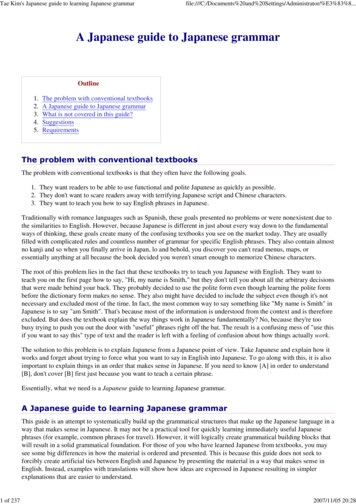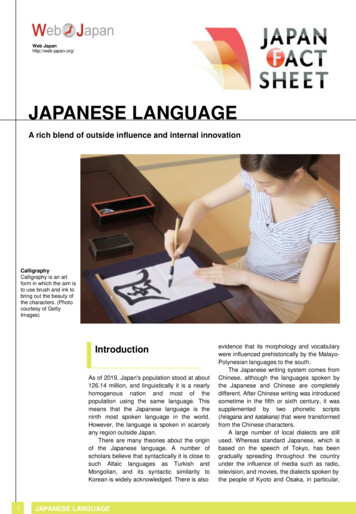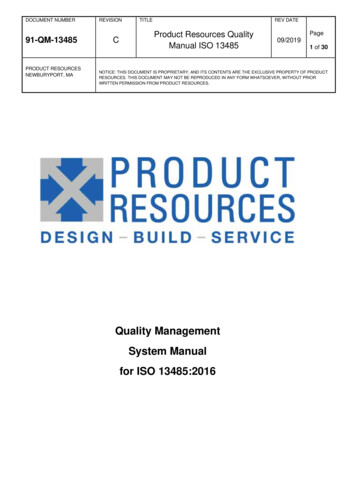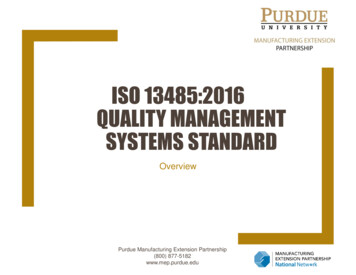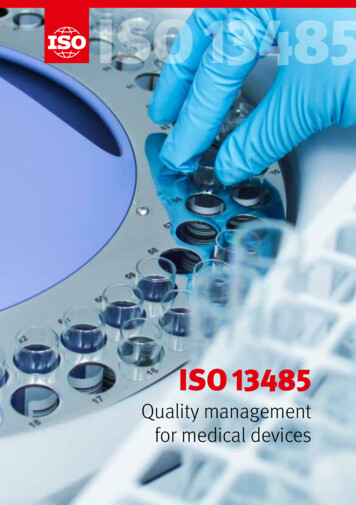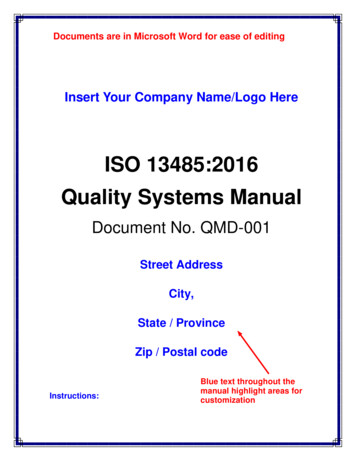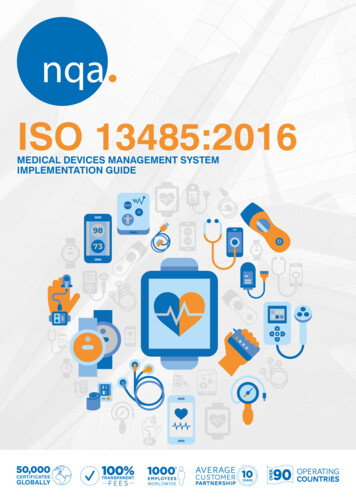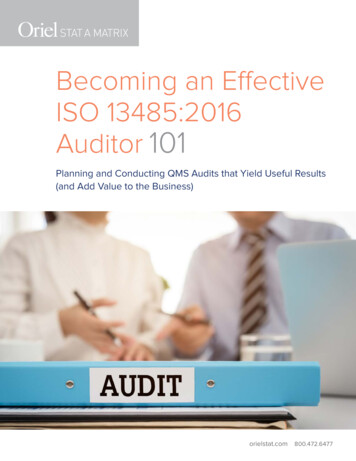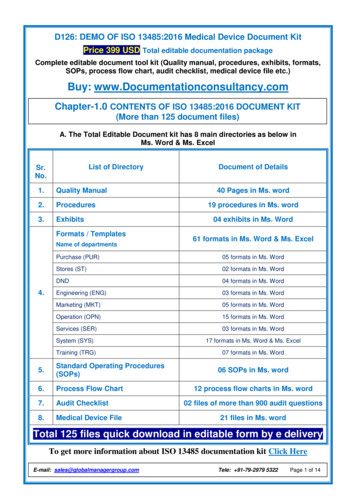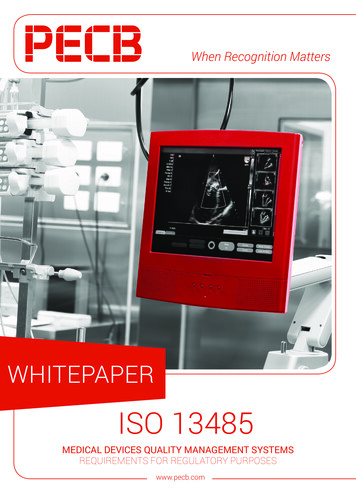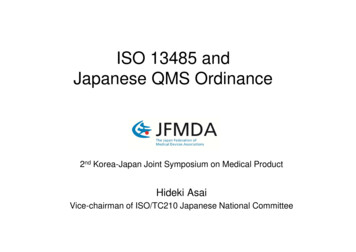
Transcription
ISO 13485 andJapanese QMS Ordinance2nd Korea-Japan Joint Symposium on Medical ProductHideki AsaiVice-chairman of ISO/TC210 Japanese National Committee
Agenda1. ISO/TC210a) ISO/TC210 Structure and Activitiesb) ISO/TC210 Japanese National Committee2. History of QMS standards3. Structure of Present Japanese QMS Ordinance4. Major difference between ISO 13485:2016 and JapaneseQMS ordinance5. ISO 13485:2016 certification in Japanese regulation6. Future of Japanese QMS Ordinance
ISO/TC210ISO/TC 210"Quality management and corresponding generalaspects for medical devices" Established in 1994 Member– P member 38 countries(including KOREA and JAPAN)– O member 17 countries
WGs of ISO/TC210 WG 01ISO 13485"Application of quality systems to medical devices"WG 02"General aspects stemming from the application of quality principles to medical devices"WG 03"Symbols and nomenclature for medical devices"WG 06"Application of post market surveillance systems to medical devices“JWG 01"Joint ISO/TC 210-IEC/SC 62A WG ; Application of risk management to medical devices"JWG 02"Joint ISO/TC 210-IEC/SC 62A WG ; Medical device software"JWG 03"Joint ISO/TC 210-IEC/SC 62A WG ; Medical device usability"JWG 04"Joint ISO/TC 210-IEC/SC 62D; Small bore connectors"WG 05"Connectors for reservoir delivery systems"
History of QMS Standards1959US Military StandardMIL-Q-98581979BS 5750 Pt 1BS 5750 Pt 2BS 5750 Pt 31987ISO 9001ISO 9002ISO 90031994ISO 9001ISO 9002ISO 90032000ISO 90011987EN 29001EN 29002EN 290031993EN 46001EN 46002EN 460031996ISO 13485ISO 134882008ISO 90012003ISO 134852015ISO 90012016ISO 134851997USA QSR2004 / 2014JapaneseQMSOrdinanceQMS for Medical Devices
TC210 Japanese National Committee Same Committee/WG Structure as TC210– TC210 Japanese National Committee TC210/WG1 Japanese National Sub-Committee TC210/WG2 Japanese National Sub-Committee �・・・・・・・・・・・・・ Chairman Secretary MembersDr. Tei (Prof of Tokyo Univ.)JFMDAAcademiaGovernment(MHLW, PMDA)Industry (JFMDA)
Japanese QMS ordinance Present Japanese QMS ordinance is based on ISO13485:2003 and have additional requirements. Design Control applies to class 2, 3, and 4 QMS ordinance is also applied to class1 device but nopre-market inspection. QMS ordinance is applied both MAH andmanufacturing site.
Structure of Japanese QMS OrdinanceChapter 1.General Provisions (Article 1 3)Chapter 2.Medical Devices Manufacturing (Article 4 64)Identical to ISO13485:2003Chapter 3.Additional Requirements (Article 65 72-3)Chapter 4.Biological-origin Medical Device, etc. Manufacturers(Domestic, Foreign) (Article 73 79)Chapter 5.In-Vitro Diagnostic Radioactive Reagents Manufacturers(Domestic, Foreign) (Article 80 81)Chapter 6.Provisions Applied Mutatis Mutandis of Medical Device, etc.Manufacturing Sites, etc.(Article 82 84)8
Chapter 2 of Japanese QMS ordinanceQMS Ordinance (Chapter 2)ISO 13485:2003Section 1 General Requirements(Article 4)1. ScopeSection 2 Quality Management System(Article 5 to Article 9)4. Quality management systemSection 3 Management responsibility(Article 10 to Article 20)5. Management ResponsibilitySection 4 Resource Management(Article 21 to Article 25)6. Resource managementSection 5 Product Realization(Article 26 to Article 53)7. Product realizationSection 6 Measurement, Analysis andImprovement(Article 54 to Article 64)8. Measurement, analysis andimprovement
ISO 13485:2016 Purpose of the change– To reflect changes in regulatory requirements andexpectations, current practices employed bymedical device providers (e.g., manufacturers,distributors, and service providers) to ensure safeand effective medical devices that meet customerrequirements.– To reflect changes to the ISO 9001:2008 standardon which this Standard is based.
Structure of New revision of ISO 13485 New Revision of ISO 13485 is not followed AnnexSL of ISO Directive because of this is not matchRegulatory Purpose. Basic structure is identical to ISO 13485:2003. Correlation Matrix of ISO 9001:2015 and ISO13485:2016 are described in Annex B. No. of Sub clause changed for MDSAP gradingissue. (7.5.1 – 7.5.11)
Contents of ISO 13485:2016ForewordIntroduction1. Scope2. Normative references3. Terms and definitions4. Quality management system5. Management Responsibility6. Resource management7. Product realization8. Measurement, analysis and improvementAnnex A (informative) Comparison of content between ISO 13485:2003 andISO 13485:2016Annex B (informative) Correspondence between ISO 13485:2016 and ISO9001:2015Bibliography
Major differencebetween ISO 13485:2016 and QMS ordinance4.1 General requirements4.1.2 (QMS Processes) Risk based thinking The organization shall:a)determine the processes needed for the quality management system and theapplication of these processes throughout the organization taking into accountthe roles undertaken by the organization;b) apply a risk based approach to the control of theappropriate processes needed for the quality managementsystem;c)determine the sequence and interaction of these processes.
Major differencebetween ISO 13485:2016 and QMS ordinance4.1 General requirements4.1.6New Requirement (Expanded)(Validation of the application of QMS software) The organization shall document procedures for the validation ofthe application of computer software used in the qualitymanagement system. Such software applications shall bevalidated prior to initial use and, as appropriate, after changes tosuch software or its application. The specific approach and activities associated with softwarevalidation and revalidation shall be proportionate to the riskassociated with the use of the software. Records of such activities shall be maintained (see 4.2.5).
Major differencebetween ISO 13485:2016 and QMS ordinance4.2.3 Medical Device FileNew requirement “SEIHIN HYOJUNSYO” in Japanese QMS ordinance(concept is already in 2003 version /New sub-clause) a)b)c)d)e)f)For each medical device type or medical device family, the organization shall establish andmaintain one or more files either containing or referencing documents generated todemonstrate conformity to the requirement of this International Standard and compliancewith applicable regulatory requirements.The content of the file(s) shall include, but is not limited to:general description of the medical device, intended use/purpose, and labelling, includingany instructions for use;specifications for product;specifications or procedures for manufacturing, packaging, storage, handling anddistribution;procedures for measuring and monitoring;as appropriate, requirements for installation;as appropriate, procedures for servicing.
Major differencebetween ISO 13485:2016 and QMS ordinance7.3 Design and development7.3.1 General7.3.2 Design and development planning7.3.3 Design and development inputs7.3.4 Design and development outputs47.3.5 Design and development review7.3.6 Design and development verification7.3.7 Design and development validation7.3.8 Design and development transfer (New Sub-clause)7.3.9 Control of design and development changes7.3.10 Design and development files (New Sub-clause)
Major differencebetween ISO 13485:2016 and QMS ordinance7.5.8 IdentificationAdded requirement for unique device identification(UDI). The organization shall document procedures for product identification and identifyproduct by suitable means throughout product realization.The organization shall identify product status with respect to monitoring andmeasurement requirements throughout product realization. Identification ofproduct status shall be maintained throughout production, storage, installationand servicing of product to ensure that only product that has passed the requiredinspections and tests or released under an authorized concession is dispatched,used or installed. If required by applicable regulatory requirements, theorganization shall document a system to assign unique deviceidentification to the medical device. The organization shall document procedures to ensure that medicaldevices returned to the organization are identified and distinguished fromconforming product.
Major differencebetween ISO 13485:2016 and QMS ordinance8 Measurement, analysis and improvement8.1 General.8.2 Monitoring and measurement8.2.1 Feedback8.2.2 Complaint handling8.2.3 Reporting to regulatory authorities(New Sub-clause)(New Sub-clause)8.2.4 Internal audit8.2.5 Monitoring and measurement of processes8.2.6 Monitoring and measurement of product8.3 Control of nonconforming product (re-arranged)8.3.1 General8.3.2 Actions in response to nonconforming product detected before delivery8.3.3 Actions in response to nonconforming product detected after delivery8.3.4 Rework8.4 Analysis of data8.5 Improvement8.5.1 General8.5.2 Corrective action8.5.3 Preventive action
ISO 13485:2016 certificationin Present Japanese Regulation Compliance to ISO13485:2016 is considered tocomply to the Chapter 2 ofJapanese QMS Ordinance.(Administrative Circular 2016/July)Requirement ofISO 13485:2003Requirement ofISO 13485:2016
Future of Japanese QMS ordinance JIS Q 13485:201X( ISO 13485:2016) will be issued soon. Health Labor Science Research Study Group for MedicalDevice QMS (Chair: Dr Sakurai/PMDA)– Research gaps between ISO 13485:2016 and JapaneseQMS ordinance.– Recommend to introduce ISO 13485:2016 to JapaneseQMS ordinance to MHLW. It is expected that Japanese QMS ordinance willharmonize with ISO 13485:2016 / Global QMS standardsoon.
Guidance for ISO 13485:2016 WG1 drafted the ISO 13485 handbook for ISO 13485:2016guidance. The draft version of this Handbook circulated for CIB andpassed CIB (positive 28, negative 1) Handbook Writing Team is working resolve the commentfor draft version now. This handbook draft will issue for final 1 month ballot soonand final version will be published in June 2017. ISO/TC210/WG1 Japanese National sub-committee willtranslate this handbook to Japanese and issue it soon afterthe final version is published.21
Questions ?Hideki Asaihideki.asai.cw@hitachi-hightech.comPhone: 81-90-5204-4880
Quality Management System(QMS)for Medical Devices in KoreaDr. Jang-yong Choi
Jangyong ChoiPictureDeputy Director ofMedical Device SafetyEvaluation Division inKorea MFDS Medical device policy, medicaldevice inspection & QMS AHWP WG member
Quality Management System(QMS)Table of ContentsI.Status of Korea Medical Device IndustryII. Organization and Regulations for medical device QMSIII. History and Regulation in detail of Korea QMSIV. Future Plan
I. Status of Korea Medical Device Industry※ Ref : Espicom. The World Medical Markets Fact Book 5, Forecasts to 2018Unit: US Million Dollarsranking it 9th inglobal market
I. Status of Korea Medical Device IndustryAbout 5,800 medical device manufacturers & importers in 2016Number of medical device business ,459Total3,7943,9074,4484,7385,2325,6375,865
I. Status of Korea Medical Device IndustryStatistic Result on KQMS ,0005000200720082009201020112012201320142015
II. Organization and Regulations for medical device QMS- Changed responsibility of MFDS & KFDA t(Consumer)DistributionMake regulations and policies as a control towerof medical device safety management2013Combination of policy and enforcementTo establish policies and draft laws regardingmedical device safety management(MoH)Before(KFDA)GCPQMSGSPOnly responsible for legalenforcement and managementrelated to medical devicesPost-marketsurveillance
II. Organization and Regulations for medical device QMS- Organizational Chart for QMS Control of MD in Korea MFDS Third-party Organization (40)Medical deviceSafety EvaluationDivision(QMS Controltower MFDS, 2)Korea Testing Laboratory(KTL, 9)Korea Testing & Research Institute(KTR, 13)Korea Testing Certification(KTC, 11)Korea Conformity Laboratory(KCL, 7)Cooperation Group(MFDS, 40)Six Regional Branch Offices(15)(Medical Product Safety Division)NIFDS (25)(National Institute of Food &Drug Safety Evaluation)High-tech medical devicesdivisionCardiovascular devicesdivisionOrthopedic & Restorativedevices divisionDental & Gastroenterologydevices divisionIn vitro diagnosticdevice division
II. Organization and Regulations for medical device QMS- Medical Device Regulations at Four Hierarchical Orders Medical Device Act (MDA)Enforcement Regulations of MDAImplementing Regulations of MDAMFDS Notifications of MDA-QMS Notification for medicaldevice is also included
III. History and Regulation of Korea QMS① ‘04.05.30 : First Introduced the MD QMS regulation② ‘07.05.31 : QMS audits including S/W validation and risk management were set to bemandatory③ ‘12.04.08 : QMS audits have been conducted on oversea manufacturing companies④ ‘13.09.16 : Class 1 medical device were exempted from QMS audits⑤ ‘16.01.28 : QMS conformity assessment before medical deivce approvalImplementingregulations for QualityManagementSystem(QMS)2004QMS ConformityAssessmentbefore approvalExemption of class 1medical device2008Mandatory applicationRisk management,Software validation,Sterilization validation20092010201120122013 Implementingforeign manufacturerQMS audit IVD - medicaldevice201420152016
III. History and Regulation of Korea QMS- Korea QMS regulation in details - Applied standard : The standard for Korea QMS conformity assurance audit,equivalent to ISO 13485 : 2003. Target :① A person who is going to manufacture or import medical devices (includingoverseas manufacturer company) Initial audits② Periodic audits every 3 years on manufactures where initial audits wereconducted Audit types :① Initial audit : An initial audit to approve QMS conformity assurance② Periodic audit : After the initial audit, at least one audit will be conducted in 3years③ Audit of approval changes : Audits to be conducted again if manufacturersnotify changes of manufacturing sites.④ Supplementary audit : Audits to be conducted if a product is added from adifferent product group.
III. History and Regulation of Korea QMS- Korea QMS regulation in details - Audit method : Conducting on-site audits and document review for eachproduct groups of manufacturing company※ Product group : Products whose raw materials, manufacturing process and qualitymanagement system are similar to those of which have been classifiedinto 26 group Certification period : 3 years (QMS conformity certification should be renewed) Miscellaneous information :① Low-risk class 1 medical devices excluded② 6 regional offices and 4 medical device quality evaluation institutions arejointly conducting on-site audit and document review
III. History and Regulation of Korea QMS The list of 26 product groups for Korea QMS conformity assurance Medical Deviceclassified2,200 Product itemsRe-categorized26 Product groupsNo.Product Groups of Medical DevicesNo.Product Groups of Medical Devices1General Equipment for Treatment14Syringes and Needles2Surgical Devices15Instruments for Dental Treatment3Medical Chambers16Sight Corrective Ophthalmic Lens4Life-support System17Hearing Aid5Artificial Internal Organ18Medicinal Substance-Producing Equipment6Diagnostic Devices19Implantable Medical Supplies7Medical Stimulating Instruments20Human Tissue and Organ Substitute8Surgical Instruments21In Vitro Medical Supplies9Patient Transport22Contraceptive Device10Physiological Measuring Instruments23Dental Alloy11In Vitro Diagnostics24Materials for Dental Treatment12Speculums for Medical Use25Analyzing Products for In Vitro Diagnosis13Instruments for Medical Treatment26U-Healthcare Medical Device
III. History and Regulation of Korea QMS The main body for QMS conformity audit in Korea ClassificationManufactClass IIInitialAuditSupplementaryauditAudit ofapproval change3rd party organizationsurer orImporterClass IIIof M.DMFDS 3rd party organizationsClass IV* Class I medical devices are not required to have a QMS conformityassessment.PeriodicAudit
III. Medical Device QMS audit processManufacturer / importer ofmedical device(includingoverseas manufacturing)1Medical Device QualityEvaluation InstitutionsMFDS(3rd party organizations)2Application of KQMS auditReceipt of application3Pre-review45Confirmation of third-partyauditor and audit date796Notice for schedule of KQMSauditPreparation of KQMS audit8Conformity10Issuing KQMS certificationNotifying to MFDS auditor aboutaudit schedulecorrection10AuditMFDS ectionCorrection request for indicateddeficiency10Notice to applicant for prohibitionof distribution
List of Published Guidelines for QMSMFDS Guidelines describes specific requirements for QMS audits.No.The Title of Guidelines1Guidelines for Software Validation of Medical Devices2Guidelines for Sterilization Validation of Medical Devices3Guidelines for Risk Management of Medical Devices4HandbooK for QMS audit of Medical Devices5Guidelines for Installation Medical Devices6Guidelines for Packaging Process Validation of Medical Devices7Guidelines for Design Control of Medical Devices8Guidelines for Washing Process Validation of Medical Devices9Guidelines for Cleanliness Control of Medical Devices1011Guidelines for Corrective action and Preventive action ofMedical DevicesGuidelines for Raw Material Purchasing and OutsourcingProcess Quality Control of Medical Devicesetc.
Ⅳ. Future Plan MFDS promotes to apply new ISO 13485, which was revised in March,2016 to Korea QMS for medical devices. To promote harmonization and communication with global partners- MFDS is going to publish an English version of “Standard of MedicalDevice Manufacturing and Quality Management(MFDS QMS Notification)”in early 2017※ Requirement for QMS audits and audit methods & process will be described in thisStandard. To harmonize and improve professionalism in QMS audit- “Class 2 medical device” is going to be fully outsourced to third partiesfor QMS audit
Thank you.Jang yong ChoiE-mail: navante1@korea.kr
Japanese QMS system/Overview of MDSAPOffice of Manufacturing/Quality and ComplianceDivision of Medical DevicesPharmaceuticals and Medical Devices AgencyJunichi Ohishi, Ph.D.1
Manufacturing/Quality and ComplianceDivision of Medical Devices(QMS)Division of Pharmaceuticals(GMP)Division of RegisteredCertification Body SupervisionDivision of Administration2
1. QMS Inspection3
Outline of QMS InspectionMAH and Manufacturing SitesMarketingAuthorization Holder (MAH)QMS ApplicationPMDAReportMHLWMinister4
Types of QMS Inspection1. Pre-Marketing Approval InspectionRequired before the marketing approval.2. Pre-partial Change Approval InspectionRequired before the partial change approval.3. Periodic Post-approval InspectionRequired for maintaining marketing approval every 5 yearssince the initial marketing approval.4. Additional InspectionRequired for the notified cases. ex) biological products, micromachine and medical devices utilizing nano-materials etc.5
Pre-Marketing Approval InspectionPeriodic Post-approval InspectionApplication forMarketing ApprovalResearch ting5 yearsPre-approvalInspection5 yearsPost-approvalInspection5 yearsPost-approvalInspection Inspection scope : MAH and all the manufacturing sites. If the product is applicable to notified cases, the additional inspection issimultaneously conducted.6
Pre-partial Change Approval InspectionPre-partial changeApplicationMarketingApprovalPre-partial changeApprovalMarketingEvery 5 yearsPre-partial ChangeApproval Inspectionex) Main assembling siteChangePost-approvalInspection Inspection scope : MAH and the change-related sites.7
QMS Inspection AuthorityProductMedicalDevices Class IVPMDA Class III and Class II without CS*PMDA Class III and Class II with CS*IVDsInspection Authority Products without CS* Products with CS*Registered certification bodyPMDARegistered certification body*CS : Certification Standards8
Manufacturing Site RegistrationManufacturing SiteDesign FacilityDefinition(1) maintains records of design and development, and(2) the responsible person should work here.Main Assembly Plant(1) is mainly responsible for QMS or productrealization, andSterilizer(1) implement sterilization process.Domestic (Japan)Distribution Center(1) store and release the products into Japanesemarket.(2) implement assembling (filling) processes.9
Example of Mfg. Site RegistrationOutside of JapanDesignSupplierSub-AssemblyIn JapanMain gistrationRequiredNot RequiredNot RequiredRequiredNot RequiredRequired10
Scope of QMS InspectionQMS InspectionMAHRequiredDesign FacilityRequiredMain Assembly PlantRequiredSterilizerRequiredonly for sterile medical deviceDomestic (Japan)Distribution CenterOther sitesRequiredDependsPMDA determines based onrisk assessment11
QMS ApplicationMAHManufacturing Site(Design Facility)Manufacturing Site(Main Assembly Plant)Manufacturing Site(Sterilizer)Manufacturing Site(Domestic Distribution Center)12
Product Families Generic names of Medical Devices and IVDs are grouped into“Product Families” depending on factors such as characteristics,usage method, risk etc. QMS inspection is conducted per “ProductFamily”.StentNon-active instrumentsCoronary stentCardiovascular catheterSingle-use surgical knifeCarotid stentPulmonary artery catheterEsophageal tubeDrug-eluting stentsfor femoral arteryCerebrospinal catheterFilter for pulmonaryfunctional testing・・・・・・・・・・・・・ CatheterThe relationship between product family and generic name isannounced by notification.13
QMS Inspection Flow6 monthsReceive application of QMS inspectionDetermine on-site or desktop inspection* exampleOn-site InspectionMAH*Desktop InspectionMfg. site A*(Main Assembly)Mfg. site B*(Design)Mfg. site C*(Distribution)Conformity assessmentIssue compliance certification and inspection report14
Documents of QMS InspectionNo.DocumentsScope1-1-3ISO13485 Certification, registered certification body’sInspection report, etc1-1-4Manufacturing process flow1-1-5Mutual relations of QMS between MAH and mfg. sites.Mfg. sites1-2-1Outline of mfg. site(Number of employees, address, products, etc)Mfg. sites1-2-2Product list for applicationMfg. sitesProductProduct family15
Example of MAH On-site Inspection ScheduleDateTimeDay 19:3012:001.Opening Meeting(1)Introduction of Inspection(2)Overview of Company and Products2. ManagementQMS organization, Quality Manual, Quality Policy andObjectives, Management Review, Internal Audit, Training etc.13:0017:303. Marketing Authorization Holder (MAH)4. Documentation and Records5. Product Documentation (including Risk Management)9:3012:006. Design and Development7. Product and Process controls13:0017:308. Purchasing Control9. Customer Related Processes10. Corrective and Preventive Actions (CAPA)11. Team Meeting of Inspectors12. Confirmation on Findings and Closing MeetingDay 2Item16
Example of Documents for Desktop InspectionNoDocumentsOutline of DocumentsSubjectLayout of all mfg. site building・Bird’s eye-view photograph or locationmap of mfg. siteMfg. sites2-1-2Floor plan・Clean room grade・Differential pressure・List or layout of representativemanufacturing and test equipmentMfg. sites2-2-1Organization chart・Responsible persons and departmentsunder QMSMfg. sites2-2-2Quality management system・Quality ManualMfg. sites2-2-3List of documents identified withQMS・Including name, number, and retentionperiod of QMS documentsMfg. sites2-3-1Seihin Hyojun Sho・The document of Seihin Hyojun Sho is allthe related documents to the productunder QMS.Product2-3-3Validation states of mfg. process・List showing plan about the mfg. processvalidation.Product2-1-117
Timeline after QMS InspectionNonconformity is graded from 1 to 6.(Reference:GHTF/SG3/N19:2012)Rank 1 to 3Compliance Cert.& Audit ReportNonconformity Reportabout 30 daysInspectionwithin 14 daysImprovement Report ( or Plan*)Rank 4 to 6Nonconformity ReportCompliance Cert.& Audit ReportWithin 15 daysInspectionwithin 14 daysConfirmation of theeffectivenessNextInspection*in case of Rank 1Confirmation of theeffectivenessNextInspectionImprovement Report18
QMS Compliance Certification 基準適合証番号 �から年月日まで19印
QMS Compliance Certification Certification No. QMS Compliance Certification MAH name MAH address Generic NameProduct NameMarketing Approval NumberProduct FamilyRegistered Manufacturing Site(Name, Address, Registered No., Manufacturing Process)We certify that the manufacturing control and quality control of the above productconforms to the QMS ordinance. Issue Date Chief Executive,Pharmaceuticals and Medical Devices Agency Term of validity 20
Typical NonconformityN 995 nonconformities(204 domestic sites)From Nov 1st 2015 to Mar 31st 2016Researched by Health Labor Sciences Research, Japan21
Example of NonconformityJapanese QMS Ordinance, Article 65 and 84(Verification of QMS of Registered Manufacturing Site)Marketing authorization holder should perform the verificationthat the manufacturer performs the manufacturing control andquality control based on the Japanese QMS ordinance.Failure to implement the verification.22
Verification of QMS of RegisteredManufacturing Site (Article reementQualityAgreementSterilizeMain AssemblyQualityAgreementDomestic DistributionJapanOverseas23
2. Participation in MDSAP24
Japan’s participation in Medical DeviceSingle Audit Program (MDSAP) MDSAP is an international initiative to implement aprogram where auditing organizations can conduct asingle audit of a manufacturer of medical devices acrossthe different regulations. Japan announced its participation in MDSAP Pilot inJune 2015. Australian TGA, Brazilian ANVISA, HealthCanada, US FDA and Japanese MHLW have beenrunning MDSAP.25
Trial acceptance of MDSAP Audit Reports PMDA accepts MDSAP audit reports as a trial. The trial period :from June 22, 2016 to December 31, 2016extended to March 31, 2018 The MDSAP Audit Report can reduce themanufacturer’s burden in the inspection process, whenit is appropriate. PMDA basically performs desktop inspection to a site towhich the MDSAP audit report is submitted at thetiming of QMS inspection application.26
Example of Documents for DesktopInspection using MDSAP Audit ReportNoDocumentsNeed or not1-1-3ISO13485 Certification, registered certification body’sInspection report, etcNot1-2-1Outline of manufacturing siteNot2-1-1Layout of manufacturing site buildingNot2-1-2Floor planNot2-2-1Organization chartNot2-2-2Quality management system manualNot2-2-3List of documents identified with QMSNot2-3-3Validation states of mfg. processNot2-4-4Quality agreement between MAH and manufacturing sitesDepends27
References PMDA / mp-qmsgctp/0002.html Documents to be submitted list for QMS fhttp://www.pmda.go.jp/files/000212616.pdf28
Thank you for your attention!29
ISO 13485:2016QMS Application StrategyMay 11, 2017ILOODA Co. Ltd.Seol Yeong-sooresponsible for quality management
Table of Contents1. ISO 13485:2016 Key Changes2. Application of Regulatory Requirements QMS3. Risk Management throughout the Product Realization4. Re-establishment of the Organization’s Files for Design and Development5. Re-establishment of Supply Products/Service Management6. Re-establishment of Complaints Handling Procedure7. Summary2
1. ISO 13485:2016 Key Changes Focus on internationalized “regulatory requirements” Apply “risk management” throughout the quality system A clear need for “design validation and validation activities” Improvement of the “supplier management” process Improved “feedback process” Clear requirements for “software validation” Enhanced requirements for “identification and traceability”* Source: SGS ACADEMY3
Regulatory Requirements Organizational emphasis on the regulatory requirementsRisk Management for customer safety and performance Requires assessment of the impact on the regulatorymanagement across the product realization activities Expansion of the quality management system as well asrequirements in the activities of the manufacturerthe product realization process (design management)Communication with and reporting to the regulatory- Introduction of the lifecycle conceptagencies on the applicable regulatory requirements Documentation of one or more processes for risk Evaluation of the impact of the “applicable regulatoryrequirements “when changing the product design, andReview of the results of the design change through riskmanagement reporting it to the approving or regulatory bodyDocumentation of the assessment of the riskmanagement on the data in the feedback processDesign Control Documentation of the planning and review of the design the validation, and of the statistical techniques andThe outputs of the design and development should besample size Documentation of the resources of the design anddevelopment process, including the suitability of theEstablishment of a design validation & validation plan, Usability, clinical and performance evaluation forvalidation, application of the design history file conceptIn the case of software, validate the extent of thepotential and design transfer If applicable, ensuring the compatibility of the productwith other medical devicesparticipants Documentation of the acceptance criteria to be used inand developme
Guidance for ISO 13485:2016 WG1 drafted the ISO 13485 handbook for ISO 13485:2016 guidance. The draft version of this Handbook circulated for CIB and passed CIB (positive 28, negative 1) Handbook Writing Team is working resolve the comment for draft version now. This handboo

